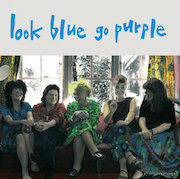Some philosophers purport that geographical isolation is a more fertile base for creativity than the bustle of a beehive of activity. Nothing suggests that to be true more than the revered outpost Flying Nun Records; a label with a back catalogue that’s arguably more of an indelible influence on the indie music of the last 30 years than anything that was coming out of the UK at the same time.
Cut off from their UK contemporaries in the first postpunk era, a group of New Zealand bands – many based in the South Island city of Dunedin – applied the self-sufficiency of punk and used it to write pop songs. Much like the UK indie pop scene of the mid- to late 80s, these bands were informed by the Byrds’ jangling guitars, 60s pop melodies and particularly the messy, light/dark dynamics of the Velvet Underground.
Generally, Flying Nun was very much a boy’s club: made up largely of bands with few or no female members, Look Blue Go Purple were the only all-female group on the label. This was something of a non-issue for the band and everyone involved at Flying Nun: women were active participants in a very creative and politically active era, charged with post-sexual revolution and determination to create anything but typical male music. Essentially, Flying Nun opposed the idea that gender had anything to do with rock ‘n’ roll, and rightly so.
Of course, amid a roster of bands with short and snappy, self-effacing names – The Bats, The Clean, The Great Unwashed, The Chills – Look Blue Go Purple were bound to stand out. Musically, they were not necessarily pioneers; they were informed by the women of UK punk – primarily The Slits and The Raincoats – whose influence was manifested in a shambolic approach to playing instruments, lyrical defiance and an unashamedly female take on pop music.
Their sound also focused on a type of gentle pop that the likes of the Chills became renowned for. Their punk spirit was manifested in their DIY ethos, while other bands – particularly The Clean – were much more musically indignant early on in their careers, utilising abrasion and chaos to denote a more overtly punk sensibility. Look Blue Go Purple were the band that defined Flying Nun’s softer, more ‘pop’ inclinations, something that’s seldom recognised among Flying Nun aficionados, presumably because their existence was rather fleeting in comparison to other bands on the label. They weren’t very prolific, and never released an LP, which prevented them from finding a foreign audience despite two of their three EPs reaching the New Zealand top 30.
Over time, however, Look Blue Go Purple have proved to be an important band of indie pop’s golden age, boosted by a heightened interest in Flying Nun. Still Bewitched collates the group’s three EPs and unreleased live rarities, making it compulsory listening for Flying Nun obsessives and those who’ve yet to be acquainted.
The collection traces the group’s trajectory from start to finish, beginning with the staunch, simplistic post-punk of their first EP, which flirted with experimentation – see the whirling synths of ‘Safety in Crosswords’ and ‘Circumspect Penelope’ – and concluding with a folk-rooted, whimsical take on traditional pop music. ‘Cactus Cat’, their best-known song, gets tantalisingly close to guitar pop perfection, but the later version of the band expanded on their earlier propensity for experimentation: see the spoken word, new wave tribalism of ‘Hiawatha’ and the subtle, fluttering brass inclusions on ‘Winged Rumour’.
The seven previously unreleased live tracks here were handpicked by the band from their final years and showcase their effervescent live presence, but more noticeably, their rejection of complacency and refusal to settle on one sound. The Raincoats’ abstract influence is particularly prominent on ‘A Request’ while ‘Juxtaposition’ displays a tougher rockabilly quality and a brilliant repetitiveness that’s not unlike The Fall in their prime. The live recordings show Look Blue Go Purple at their best: playful, melodic, and far less timid than their recorded output would have you believe.
Still Bewitched demonstrates the group’s relevance in 2017: listened to out of context, you could be forgiven for mistaking Look Blue Go Purple for a new band and Still Bewitched as adhering to the indie pop formula rather than helping to create it. Through an emphatically lo-fi production, primitive instrumentation and a generally detached disposition, they envisaged the dominance of what the genre would eventually become. Make no mistake, Still Bewitched is a snapshot of New Zealand’s DIY scene of the 1980s and indie pop’s pinnacle. Look Blue Go Purple should now get the credit they deserve, and be remembered for what they are: vital proponents of a vibrant, inspirational scene that was, and still is, significant to many people.


